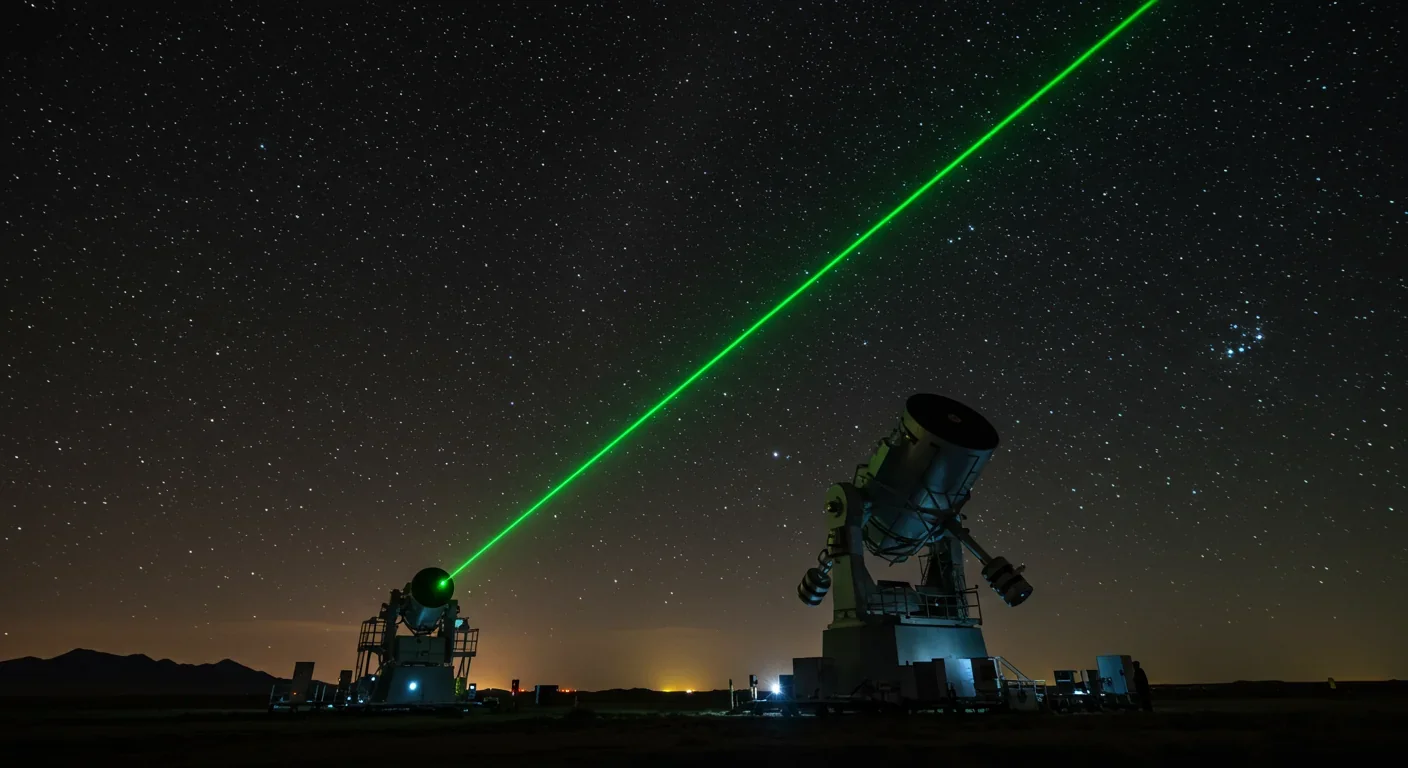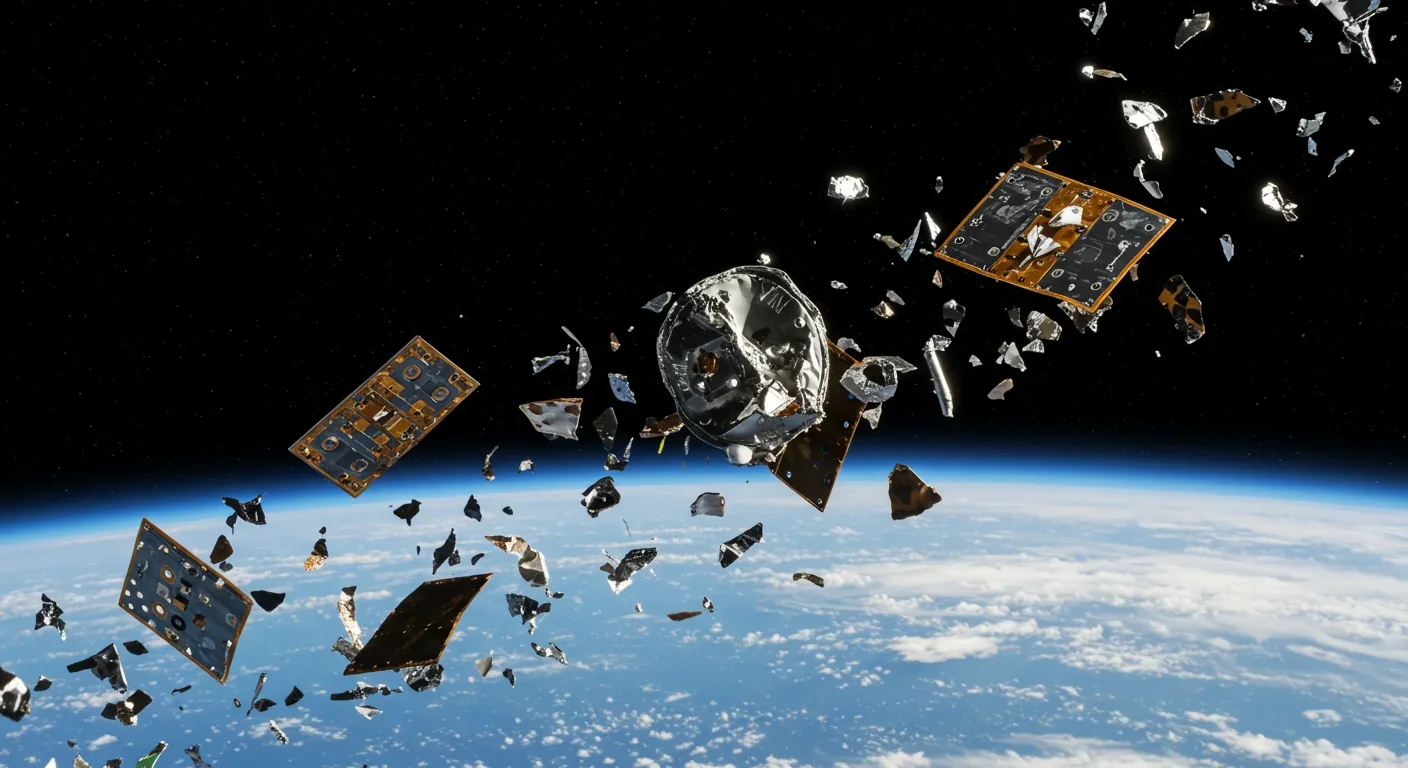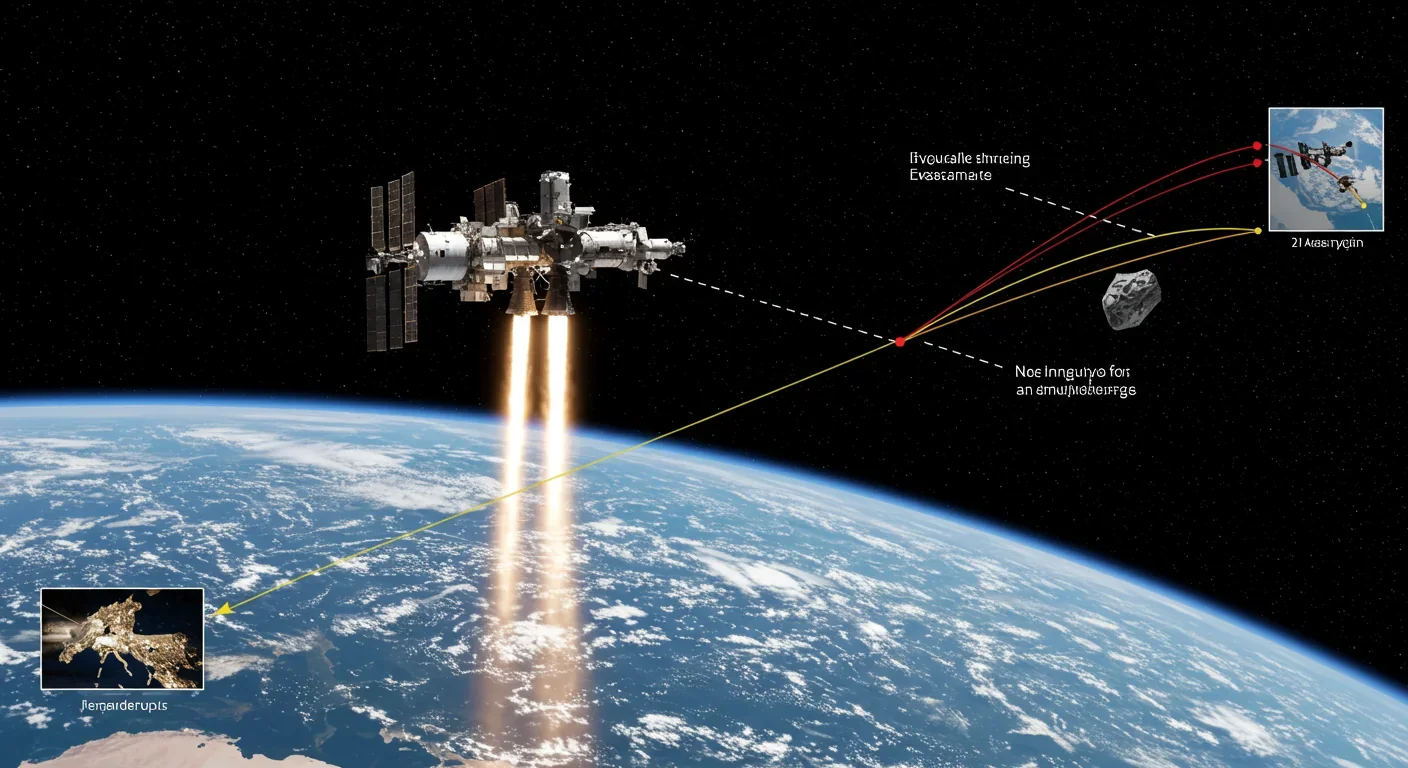Fusion Rockets Could Reach 10% Light Speed: The Breakthrough

TL;DR: Ground-based laser systems using photon pressure and ablation are emerging as a cost-effective solution to space debris, with operational systems in Europe and development in China, Japan, and the US. These systems can deflect dozens of debris objects daily at €2,500 per object, far cheaper than robotic capture missions. However, dual-use weapons concerns and lack of international regulations remain major obstacles to deployment.

Picture this: in November 2024, the International Space Station performed two emergency maneuvers in six days, dodging chunks of debris traveling at thousands of kilometers per hour. Each maneuver costs fuel, disrupts research, and reminds astronauts just how crowded orbit has become. But what if we could nudge that junk out of the way before it becomes a threat? What if, instead of playing defense, we went on offense with precisely aimed lasers?
Ground-based laser systems are emerging as one of the most promising solutions to Earth's orbital debris crisis. These aren't science fiction beam weapons, they're real systems being built right now in Spain, China, Japan, and the United States. They use photon pressure and controlled ablation to gently push defunct satellites and orbital fragments away from collision courses with working spacecraft.
Space is getting uncomfortably crowded. As of early 2025, more than 46,600 objects are tracked in orbit, though only about 10,500 are active satellites. The rest? Dead satellites, spent rocket stages, fragments from explosions and collisions. ESA estimates there are 128 million pieces of debris smaller than a centimeter, about 900,000 pieces between one and ten centimeters, and roughly 34,000 pieces larger than ten centimeters circling overhead.
These numbers keep growing. In a six-month period during 2024, SpaceX's Starlink constellation performed 50,000 collision avoidance maneuvers, averaging 14 maneuvers per satellite. That's not sustainable. The ISS has conducted 39 debris avoidance maneuvers since 1998, and experts warn the frequency is trending upward.
In February 2024, a 35-year-old Russian spy satellite and a 25-year-old NASA scientific satellite missed each other by just 33 feet, roughly the length of a school bus. Both were traveling at orbital velocity. A collision would have created thousands of new fragments, each one a potential threat.
The stakes couldn't be higher. Modern civilization depends on satellites for GPS navigation, weather forecasting, telecommunications, financial transactions, military operations, and climate monitoring. Lose access to orbit because of a cascading debris collision event, known as Kessler Syndrome, and we lose much of what makes 21st-century life function.
Forget Hollywood's exploding asteroids. Real laser deflection is more subtle, more precise, and arguably more elegant. There are two main approaches: photon pressure and laser ablation.
Photon pressure uses the fact that light carries momentum. When photons from a laser beam strike an object in space, they transfer tiny amounts of momentum, creating thrust. It's the same principle that makes solar sails work. ESA's Izaña-2 telescope in Tenerife uses this method to gently push debris, firing energetic pulses at targets to nudge them onto safer trajectories.
The forces are minuscule, roughly femtonewtons per watt of laser power, but orbital mechanics amplify small changes over time. A tiny push today becomes a significant orbit change weeks later. André Kloth, Managing Director at DiGOS, explains: "One possibility is laser momentum transfer to gently push the space debris on its orbit a little bit away so it doesn't collide with orbiting satellites."
Laser ablation takes a more aggressive approach. High-powered lasers heat one side of debris until material vaporizes, creating a tiny rocket thruster effect. The ablated material shoots off in one direction, pushing the debris in the opposite direction. This generates more thrust than photon pressure alone, allowing faster orbital changes.
Both methods require extraordinary precision. Ground-based systems must compensate for atmospheric turbulence using adaptive optics, the same technology that sharpens images from astronomical telescopes. They need to focus laser beams on targets the size of softballs located 800 to 1,000 kilometers away, moving at 7.5 kilometers per second.
The Orion project in the 1990s proposed a 20-kilowatt pulsed laser that could deorbit dozens of debris objects daily. Modern systems are exploring even higher power levels, with proposals for megawatt-class lasers that could handle larger targets or operate at greater distances.

Multiple countries and organizations are racing to deploy operational laser deflection systems, each taking slightly different approaches.
Europe leads in operational demonstrations. ESA's Izaña-1 and Izaña-2 telescopes atop Mount Teide in Tenerife became operational in 2023. The high-altitude location reduces atmospheric distortion, and the system operates in both daytime and nighttime conditions. Izaña-1 tracks debris, while Izaña-2 fires more powerful pulses to push it. Together they form an integrated tracking and deflection system feeding into ESA's OMLET project for on-demand space traffic management.
The EU's STRATOLASER project takes a novel approach: mounting lasers on stratospheric balloons. By eliminating most atmospheric attenuation, stratospheric lasers dramatically reduce power requirements. STRATOLASER aims for a cost of €2,500 per debris object removed, potentially making it the most economically viable approach. The system targets debris ranging from a few centimeters to several tens of centimeters.
China is developing both ground-based and space-based laser systems. Chinese laboratories have demonstrated a space-based laser system on a chaser satellite capable of targeting debris up to 20 centimeters. The country's rapid expansion in space capabilities, combined with experience in high-powered laser development, makes China a major player in debris removal technology.
Australia contributed early conceptual work through EOS Space Systems, which proposed ground-based laser tracking and deflection as part of active debris removal strategies. Though still largely in the planning phase, their work influenced international thinking about laser-based solutions.
NASA explored laser deflection through the Orion project in the 1990s and continues research today. The agency's focus has expanded to include both ground-based and potential space-based laser systems, though operational deployment remains years away. NASA also maintains extensive debris tracking and characterization capabilities through Johnson Space Center's integrated team of scientists and engineers.
Japan is taking a regulatory leadership role, launching international rules for space debris removal and aiming to establish unified international standards by 2026. Japan's strategy focuses on object identification, safe disposal methods, and international cooperation, recognizing that laser systems will need global coordination to deploy safely.
Building a system that can zap debris hundreds of kilometers overhead isn't simple. Multiple cutting-edge technologies must work in concert: high-power lasers with high repetition rates, focusing systems that maintain beam quality over distances exceeding 1,000 kilometers, atmospheric compensation to counteract turbulence, and tracking systems that keep the beam locked onto targets moving at hypersonic speeds.
Atmospheric distortion is the first major hurdle. Earth's atmosphere bends, scatters, and absorbs laser light, especially near the ground where density is highest. Temperature variations, wind, and humidity all degrade beam quality. Adaptive optics partially solve this by using deformable mirrors that change shape hundreds of times per second, correcting for atmospheric distortion in real time. It's like trying to thread a needle through a waterfall, then having the waterfall fight back.
Power requirements scale brutally with target size and distance. A one-megajoule pulsed hydrogen fluoride laser can theoretically deorbit dozens of one-to-ten-centimeter debris objects daily, but building and powering such a system is expensive. Larger targets require proportionally more energy. Space-based lasers avoid atmospheric losses but face their own challenges: launch costs, power generation in orbit, and heat dissipation in vacuum.
Tracking precision becomes exponentially harder as debris gets smaller and faster. The U.S. Space Surveillance Network tracks objects as small as five centimeters in low Earth orbit, but millions of smaller fragments remain untracked. You can't deflect what you can't see. Even for tracked objects, predicting orbits precisely enough to aim a laser requires continuous monitoring and sophisticated computational models.
Timing and coordination add another layer of complexity. Debris moves fast, cross-range velocities can exceed several kilometers per second. Ground stations have limited visibility windows as debris passes overhead. Coordinating multiple ground stations to provide continuous coverage requires international cooperation and real-time data sharing, neither of which exists at scale today.
Here's the uncomfortable truth: a laser powerful enough to deflect debris is also powerful enough to disable or destroy satellites. The same adaptive optics and tracking systems that enable debris removal could target functioning spacecraft. That dual-use capability makes laser deflection a regulatory and diplomatic minefield.
Under international law, any capture, deflection, or interference with a piece of debris constitutes a "national activity in outer space", meaning the authorizing country becomes internationally responsible for any damage or unintended consequences. The 1967 Outer Space Treaty and subsequent agreements establish frameworks for responsible behavior, but they predate laser deflection technology by decades.
Nobody wants to be the first to deploy what could be perceived as a space weapon. Adaptive optics technology has military applications, and programs like the U.S. Missile Defense Agency's Airborne Laser explicitly target satellites. Ground-based laser systems capable of reaching orbit blur the line between defensive debris removal and offensive anti-satellite capabilities.
China and Russia have both expressed concerns about Western laser programs. Europe and the United States worry about Chinese military-civil fusion in space technology. Japan's push for international standards by 2026 reflects recognition that obtaining widespread commitment to debris rules faces obstacles similar to climate change negotiations: immediate costs versus long-term collective benefits.
One proposed solution is transparency: sharing targeting data, allowing international observation of laser operations, and establishing clear protocols for when and how lasers can be used. Another is multinational control, where no single nation operates laser systems independently. Neither approach has gained traction yet, because trust is in short supply and national security concerns dominate.

Economics might decide this debate. Active debris removal typically involves launching spacecraft to capture and deorbit defunct satellites. ESA's ClearSpace-1 mission, planned for 2026, will demonstrate robotic capture of a single piece of debris. The mission costs tens of millions of euros for one target.
Ground-based laser systems, by contrast, could process dozens of targets daily once operational. The Orion project estimated $500 million for initial deployment in the 1990s. Inflation-adjusted, that's roughly $1 billion today. STRATOLASER aims for €2,500 per object removed, orders of magnitude cheaper than capture missions.
But those numbers hide complexity. Ground stations require land, power infrastructure, and maintenance. Atmospheric conditions limit effectiveness, multiple stations scattered globally would improve coverage but multiply costs. Space-based lasers avoid atmospheric problems but face enormous launch expenses and operational challenges.
Robot capture missions excel at removing large, intact satellites, the most dangerous debris. Lasers work best on smaller fragments that pose collision threats but aren't worth individual capture missions. The two approaches complement each other rather than compete directly.
There's also the "do nothing" cost. ESA estimates satellites perform over 1,000 collision avoidance maneuvers annually. Each maneuver uses propellant, shortens satellite lifespan, disrupts service, and adds operational complexity. Insurance premiums rise as collision risk increases. Eventually, certain orbital zones may become too dangerous to use economically.
A functional laser deflection network could reduce avoidance maneuvers, extend satellite lifetimes, lower insurance costs, and prevent cascade collisions that would render entire orbital shells unusable. Those benefits accrue globally but require upfront investment that benefits everyone including free-riders. Classic tragedy of the commons.
Optimistic timelines put operational laser deflection systems five to ten years away. ESA's Izaña telescopes are operational now for tracking and small-scale demonstrations. STRATOLASER aims for Technology Readiness Level 4 experimental campaigns soon. China's development pace is unclear but likely aggressive given their space program's ambitions.
What's missing isn't technology, it's agreements. Japan's push for international standards by 2026 represents one path forward. The United States hasn't yet established a domestic space traffic management program, much less led international coordination. The Office of Space Commerce's TraCSS system began beta operations in September 2024, monitoring just 1,000 objects initially.
Building consensus takes time. The debris problem accelerates faster than regulatory frameworks evolve. Large satellite constellations, Starlink already has over 7,000 satellites, will add tens of thousands more objects in coming years. Each failed satellite, each collision, worsens the problem.
Some experts advocate for limited deployment now under existing frameworks, demonstrating capability and building operational experience before comprehensive regulations solidify. Others insist on global agreements first to prevent weaponization or unilateral actions that damage diplomatic relations.
Political will remains the wild card. A major collision that destroys critical infrastructure or kills astronauts could galvanize action. So could a successful demonstration that shows laser deflection works safely and effectively. Absent a crisis or breakthrough, expect slow progress as nations negotiate, test prototypes, and jockey for advantage.
Whether you're a satellite operator, aerospace engineer, policy maker, or someone who relies on GPS to find the nearest coffee shop, laser deflection matters to you. Here's what to watch and how different stakeholders can prepare.
For governments: Prioritize international cooperation over national advantage. Debris doesn't respect borders, and unilateral laser deployment risks escalation. Support Japan's standards efforts, fund transparent research programs, and establish clear protocols for defensive use. Space traffic management infrastructure like TraCSS needs expansion and international data sharing.
For satellite operators: Design for end-of-life disposal. Laser deflection helps but can't solve everything. Satellites that deorbit themselves after missions end reduce the debris future systems must handle. Participate in collision avoidance data sharing, even with competitors. Your survival depends on everyone else's responsible behavior.
For researchers and engineers: The technical challenges, atmospheric compensation, high-power lasers, precision tracking, are worth solving regardless of debris applications. Advances in these fields benefit astronomy, communications, and directed energy research broadly. Keep developing dual-use technologies with civilian applications clearly prioritized.
For the rest of us: Recognize that space is infrastructure we all depend on. Support funding for debris research and removal. Demand accountability from satellite operators who litter orbit. Understand that preventing debris crises now costs far less than recovering from cascade collisions later.
The laser revolution in space debris management isn't guaranteed. It requires technical innovation, diplomatic skill, economic investment, and political will, all applied simultaneously. But if we pull it off, we keep space open for exploration, science, commerce, and all the ways humanity benefits from looking beyond our own horizons. The alternative, a debris-choked orbital environment where collision risk makes spaceflight untenable, isn't worth contemplating. So we'll build the lasers, negotiate the treaties, and zap the junk before it destroys what we've built. Because the future of space depends on what we do right now.

Recent breakthroughs in fusion technology—including 351,000-gauss magnetic fields, AI-driven plasma diagnostics, and net energy gain at the National Ignition Facility—are transforming fusion propulsion from science fiction to engineering frontier. Scientists now have a realistic pathway to accelerate spacecraft to 10% of light speed, enabling a 43-year journey to Alpha Centauri. While challenges remain in miniaturization, neutron management, and sustained operation, the physics barriers have ...

Epigenetic clocks measure DNA methylation patterns to calculate biological age, which predicts disease risk up to 30 years before symptoms appear. Landmark studies show that accelerated epigenetic aging forecasts cardiovascular disease, diabetes, and neurodegeneration with remarkable accuracy. Lifestyle interventions—Mediterranean diet, structured exercise, quality sleep, stress management—can measurably reverse biological aging, reducing epigenetic age by 1-2 years within months. Commercial ...

Data centers consumed 415 terawatt-hours of electricity in 2024 and will nearly double that by 2030, driven by AI's insatiable energy appetite. Despite tech giants' renewable pledges, actual emissions are up to 662% higher than reported due to accounting loopholes. A digital pollution tax—similar to Europe's carbon border tariff—could finally force the industry to invest in efficiency technologies like liquid cooling, waste heat recovery, and time-matched renewable power, transforming volunta...

Humans are hardwired to see invisible agents—gods, ghosts, conspiracies—thanks to the Hyperactive Agency Detection Device (HADD), an evolutionary survival mechanism that favored false alarms over fatal misses. This cognitive bias, rooted in brain regions like the temporoparietal junction and medial prefrontal cortex, generates religious beliefs, animistic worldviews, and conspiracy theories across all cultures. Understanding HADD doesn't eliminate belief, but it helps us recognize when our pa...

The bombardier beetle has perfected a chemical defense system that human engineers are still trying to replicate: a two-chamber micro-combustion engine that mixes hydroquinone and hydrogen peroxide to create explosive 100°C sprays at up to 500 pulses per second, aimed with 270-degree precision. This tiny insect's biochemical marvel is inspiring revolutionary technologies in aerospace propulsion, pharmaceutical delivery, and fire suppression. By 2030, beetle-inspired systems could position sat...

The U.S. faces a catastrophic care worker shortage driven by poverty-level wages, overwhelming burnout, and systemic undervaluation. With 99% of nursing homes hiring and 9.7 million openings projected by 2034, the crisis threatens patient safety, family stability, and economic productivity. Evidence-based solutions—wage reforms, streamlined training, technology integration, and policy enforcement—exist and work, but require sustained political will and cultural recognition that caregiving is ...

Every major AI model was trained on copyrighted text scraped without permission, triggering billion-dollar lawsuits and forcing a reckoning between innovation and creator rights. The future depends on finding balance between transformative AI development and fair compensation for the people whose work fuels it.